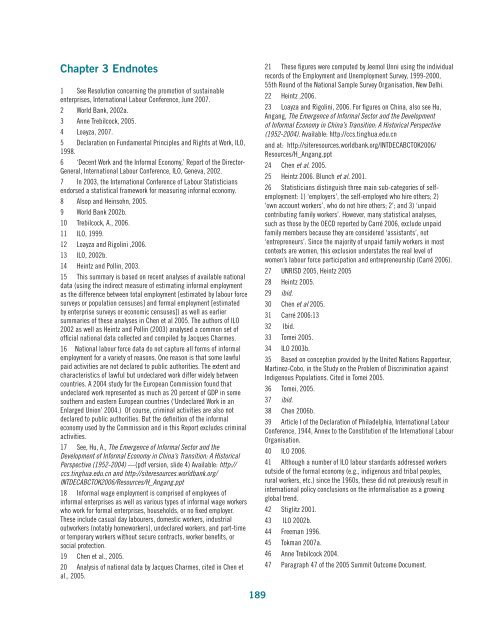Download the file - United Nations Rule of Law
Download the file - United Nations Rule of Law
Download the file - United Nations Rule of Law
You also want an ePaper? Increase the reach of your titles
YUMPU automatically turns print PDFs into web optimized ePapers that Google loves.
Chapter 3 Endnotes1 See Resolution concerning <strong>the</strong> promotion <strong>of</strong> sustainableenterprises, International Labour Conference, June 2007.2 World Bank, 2002a.3 Anne Trebilcock, 2005.4 Loayza, 2007.5 Declaration on Fundamental Principles and Rights at Work, ILO,1998.6 ‘Decent Work and <strong>the</strong> Informal Economy,’ Report <strong>of</strong> <strong>the</strong> Director-General, International Labour Conference, ILO, Geneva, 2002.7 In 2003, <strong>the</strong> International Conference <strong>of</strong> Labour Statisticiansendorsed a statistical framework for measuring informal economy.8 Alsop and Heinsohn, 2005.9 World Bank 2002b.10 Trebilcock, A., 2006.11 ILO, 1999.12 Loayza and Rigolini ,2006.13 ILO, 2002b.14 Heintz and Pollin, 2003.15 This summary is based on recent analyses <strong>of</strong> available nationaldata (using <strong>the</strong> indirect measure <strong>of</strong> estimating informal employmentas <strong>the</strong> difference between total employment [estimated by labour forcesurveys or population censuses] and formal employment [estimatedby enterprise surveys or economic censuses]) as well as earliersummaries <strong>of</strong> <strong>the</strong>se analyses in Chen et al 2005. The authors <strong>of</strong> ILO2002 as well as Heintz and Pollin (2003) analysed a common set <strong>of</strong><strong>of</strong>fi cial national data collected and compiled by Jacques Charmes.16 National labour force data do not capture all forms <strong>of</strong> informalemployment for a variety <strong>of</strong> reasons. One reason is that some lawfulpaid activities are not declared to public authorities. The extent andcharacteristics <strong>of</strong> lawful but undeclared work differ widely betweencountries. A 2004 study for <strong>the</strong> European Commission found thatundeclared work represented as much as 20 percent <strong>of</strong> GDP in somesou<strong>the</strong>rn and eastern European countries (‘Undeclared Work in anEnlarged Union’ 2004.) Of course, criminal activities are also notdeclared to public authorities. But <strong>the</strong> defi nition <strong>of</strong> <strong>the</strong> informaleconomy used by <strong>the</strong> Commission and in this Report excludes criminalactivities.17 See, Hu, A., The Emergence <strong>of</strong> Informal Sector and <strong>the</strong>Development <strong>of</strong> Informal Economy in China’s Transition: A HistoricalPerspective (1952-2004) —(pdf version, slide 4) Available: http://ccs.tinghua.edu.cn and http://siteresources.worldbank.org/INTDECABCTOK2006/Resources/H_Angang.ppt18 Informal wage employment is comprised <strong>of</strong> employees <strong>of</strong>informal enterprises as well as various types <strong>of</strong> informal wage workerswho work for formal enterprises, households, or no fi xed employer.These include casual day labourers, domestic workers, industrialoutworkers (notably homeworkers), undeclared workers, and part-timeor temporary workers without secure contracts, worker benefi ts, orsocial protection.19 Chen et al., 2005.20 Analysis <strong>of</strong> national data by Jacques Charmes, cited in Chen etal., 2005.21 These fi gures were computed by Jeemol Unni using <strong>the</strong> individualrecords <strong>of</strong> <strong>the</strong> Employment and Unemployment Survey, 1999-2000,55th Round <strong>of</strong> <strong>the</strong> National Sample Survey Organisation, New Delhi.22 Heintz ,2006.23 Loayza and Rigolini, 2006. For fi gures on China, also see Hu,Angang, The Emergence <strong>of</strong> Informal Sector and <strong>the</strong> Development<strong>of</strong> Informal Economy in China’s Transition: A Historical Perspective(1952-2004). Available: http://ccs.tinghua.edu.cnand at: http://siteresources.worldbank.org/INTDECABCTOK2006/Resources/H_Angang.ppt24 Chen et al. 2005.25 Heintz 2006. Blunch et al. 2001.26 Statisticians distinguish three main sub-categories <strong>of</strong> selfemployment:1) ‘employers’, <strong>the</strong> self-employed who hire o<strong>the</strong>rs; 2)‘own account workers’, who do not hire o<strong>the</strong>rs; 2’; and 3) ‘unpaidcontributing family workers’. However, many statistical analyses,such as those by <strong>the</strong> OECD reported by Carré 2006, exclude unpaidfamily members because <strong>the</strong>y are considered ‘assistants’, not‘entrepreneurs’. Since <strong>the</strong> majority <strong>of</strong> unpaid family workers in mostcontexts are women, this exclusion understates <strong>the</strong> real level <strong>of</strong>women’s labour force participation and entrepreneurship (Carré 2006).27 UNRISD 2005, Heintz 200528 Heintz 2005.29 ibid.30 Chen et al 2005.31 Carré 2006:1332 Ibid.33 Tomei 2005.34 ILO 2003b.35 Based on conception provided by <strong>the</strong> <strong>United</strong> <strong>Nations</strong> Rapporteur,Martinez-Cobo, in <strong>the</strong> Study on <strong>the</strong> Problem <strong>of</strong> Discrimination againstIndigenous Populations. Cited in Tomei 2005.36 Tomei, 2005.37 ibid.38 Chen 2006b.39 Article I <strong>of</strong> <strong>the</strong> Declaration <strong>of</strong> Philadelphia, International LabourConference, 1944, Annex to <strong>the</strong> Constitution <strong>of</strong> <strong>the</strong> International LabourOrganisation.40 ILO 2006.41 Although a number <strong>of</strong> ILO labour standards addressed workersoutside <strong>of</strong> <strong>the</strong> formal economy (e.g., indigenous and tribal peoples,rural workers, etc.) since <strong>the</strong> 1960s, <strong>the</strong>se did not previously result ininternational policy conclusions on <strong>the</strong> informalisation as a growingglobal trend.42 Stiglitz 2001.43 ILO 2002b.44 Freeman 1996.45 Tokman 2007a.46 Anne Trebilcock 2004.47 Paragraph 47 <strong>of</strong> <strong>the</strong> 2005 Summit Outcome Document.189
















